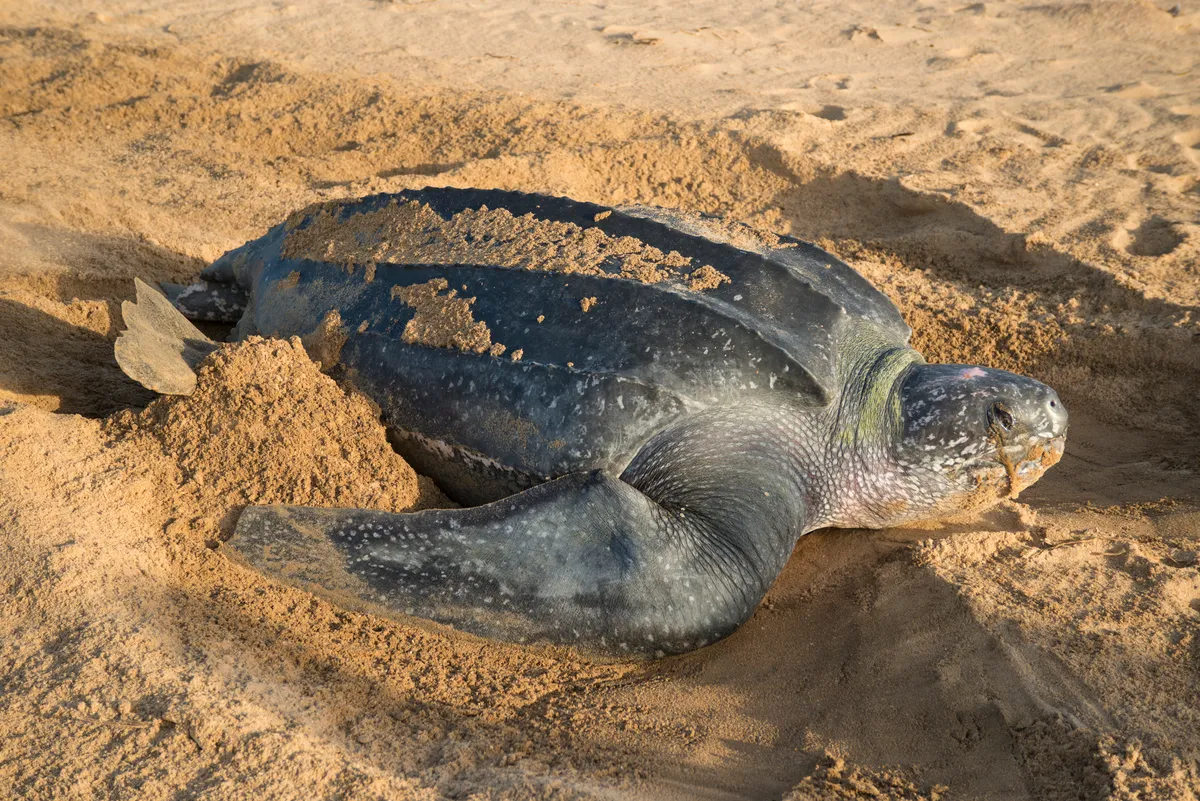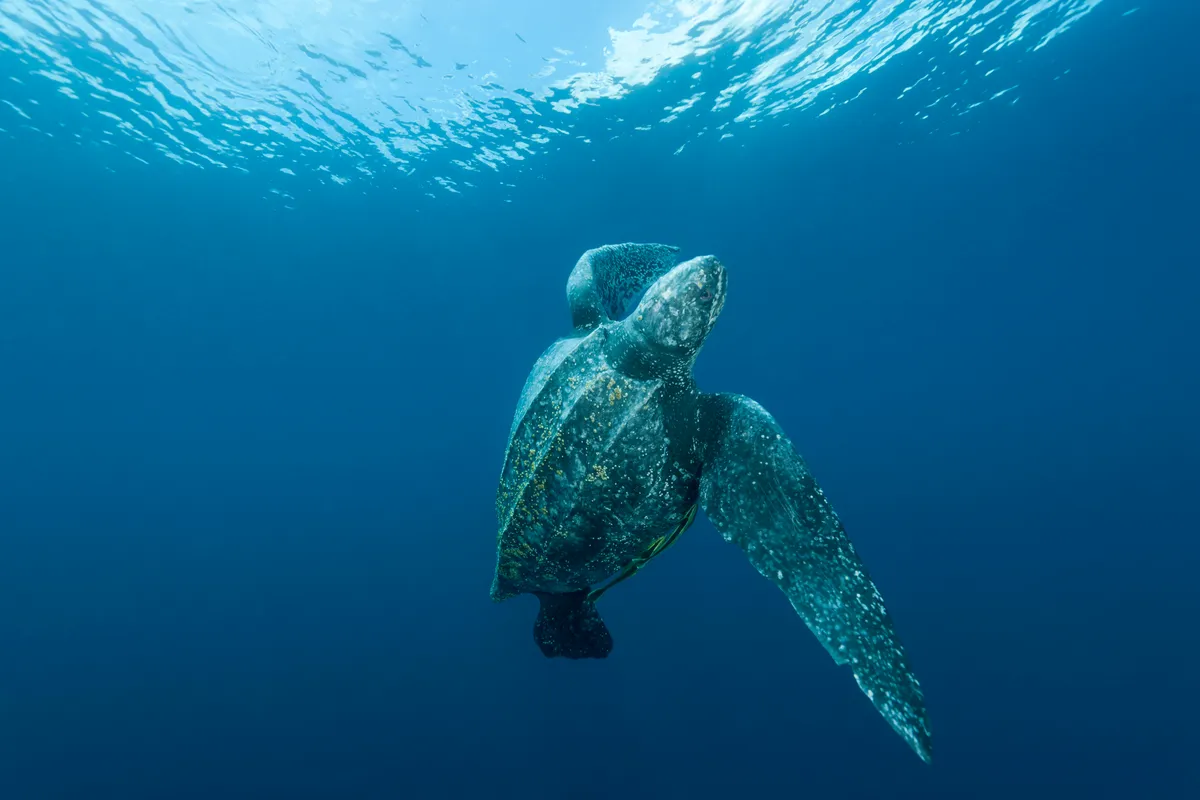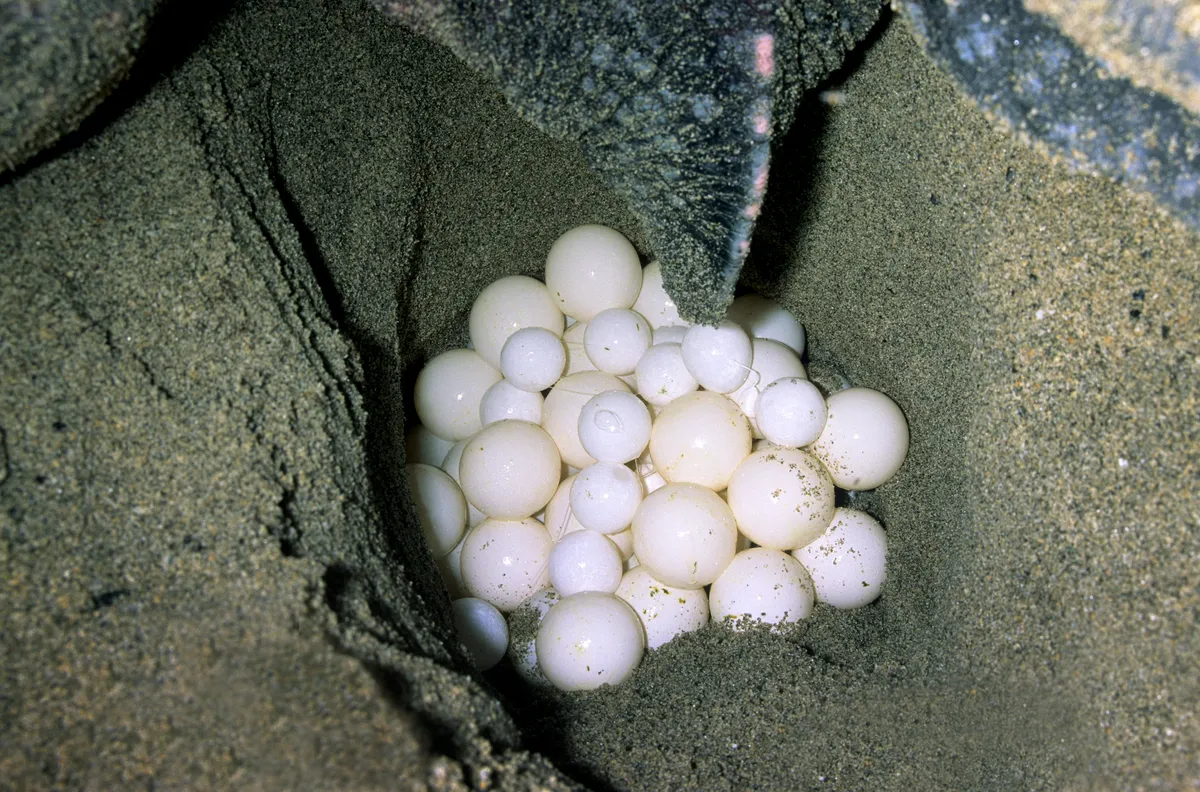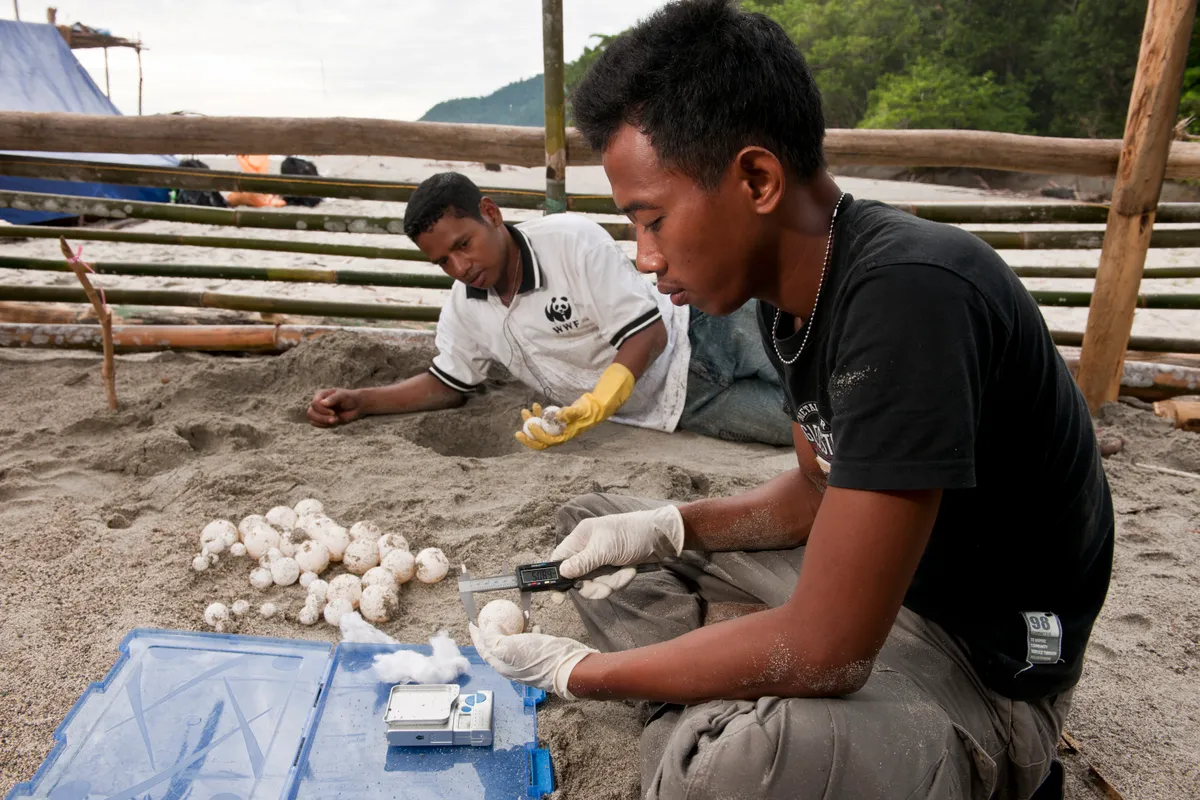Of the seven sea turtle species in the world, five have been recorded in the waters around Britain, including, leatherback, loggerhead, kemp’s ridley, green, and hawksbill.
Leatherback turtles are by far the most frequently recorded turtle in the UK as they spend time feeding on jellyfish in cool British waters. Most other turtles do not belong near the UK, preferring warmer waters, and are only found as weak juveniles, swept too far north by sea currents.
What are leatherback turtles?
They appear straight out of prehistory – and they are; the reptiles have survived mostly unchanged since the age of the dinosaurs. They are a soft shelled turtle with thick, black, rubbery skin where a carapace would be.
Why are they called leatherback?
They get their name from the leathery appearance of their shells, speckled with white spots. They have ridges along the shell ending in a blunt point to make the turtle more hydrodynamic.
They are best seen in August and September off of the south and west coasts of Britain and Ireland. They are occasionally seen off of Scotland, where whale species can also be seen.

Are leatherback turtles warm blooded?
Yes – if they weren’t, they wouldn’t be able to live in such cold temperatures, and hold their title as the most widely distributed turtle. They are able to maintain their body temperature warmer than the ocean around them, at about 18C above ambient water temperature, which enables them to forage for delicious jellyfish in temperate waters, and complete deep dives in the frigid deep ocean, up to 1000 metres down.
How big are leatherback turtles?
The largest leatherback ever recorded was 2.91 metres, and 916 kg. The specimen was over 100 years old, and only washed ashore drowned after becoming entangled in fishing line – presumably, it could have lived longer and grown bigger. While this account was exceptional, most grow over 1.7 metres in length and weigh over 454kg. They are the largest species of turtle by far, and soft shelled.
It’s important that the turtles get to be so big, because the bigger you are, the less body heat you lose to the surrounding water.
What do leatherback turtles eat?
Leatherback turtles eat jellyfish, and they have to eat a lot of them. It’s not easy to reach a leatherback’s colossal size on an organism that’s 95% water – leatherbacks have to eat 73% of their body weight in jellyfish per day to do it.
Recently, scientists have studied leatherback feeding patterns by attaching video cameras to their shells. It was found that they mostly fed in the deep ocean, away from the surface, and that they followed jellyfish blooms in order to make feeding more efficient.
They have also been recorded eating small amounts of sea urchins, squid, crustaceans, tunicates, fish, algae and seaweed.
Do leatherback turtles have teeth?
No – no species of sea turtle has teeth, and instead have beaks. Leatherbacks are different from other species that eat hard bodied prey in that they do not have crushing plates, but rather a throat covered in spiky looking protrusions like an iron maiden.
The spiky protrusions, papillae, are suited to eating a diet of soft bodied jellies, keeping the gelatinous prey securely down the hatch. Unfortunately, these same papillae make it impossible for the turtle to spit out a plastic bag they might ingest, even if they sensed it wasn’t something they wanted to eat.
What are a leatherback turtle's predators?
As a juvenile, sea turtles face many threats on the nesting beach, however, once they get to a certain size, they are mostly safe. Tiger sharks and killer whales both pose a threat to leatherback turtles.

Do leatherback turtles migrate?
Yes, all turtles migrate. Once leatherbacks clear the nesting beach, they spend years at an unknown location growing bigger. Because small turtles are so difficult to track we know little about them during this time, but they probably stay in tropical waters until they are over 100cm in carapace length.
It is difficult to know when sea turtles in general reach sexual maturity – their growth rates are effected by availability of food more than anything else, and turtles of the same age may be vastly different sizes. The most reliable way to determine sexual maturity is through a necropsy on a dead animal, but to study live specimens, researchers must insert an instrument into the animal to view the gonads and determine their developmental stage.
When they reach sexual maturity, they undertake migrations of 7000km from feeding to breeding grounds – feeding in temperate waters in the summer and breeding in tropical waters in the winter. They sometimes feed off the coast of Britain in the summer.
Where do leatherback turtles lay their eggs?
Atlantic and Pacific leatherbacks are distinct species, separated geographically, they never meet, and they lay their eggs at different locations. The pacific populations are split into eastern and western pacific subspecies, and the eastern pacific leatherback is genetically distinct from other populations.
Atlantic leatherbacks are the turtles we might see in Britain. These turtles might be from Gabon, Africa – the most important leatherback nesting beach. They may also be from the few other nesting beaches that exist, in French Guiana, the Caribbean, Puerto Rico, the Virgin Islands, and Florida.
However, turtle nesting beaches are affected by many factors – land development fringes important beaches, light pollution confuses laying females and hatchlings, pollution and littering cause beach debris, and humans can also disturb nesting turtles or nests, on purpose or by accident.
Interestingly, female leatherbacks are the only species of sea turtle that changes their preference for nesting beach, and does not necessarily return to the same one year after year.

How does a leatherback turtle choose a nesting site?
The practicalities of laying a nest on the beach are often overlooked. Humans and other animals can easily dig out the nest or otherwise disturb it, and high tides threaten to drown the eggs, which must be kept dry before hatching.
Rising sea levels, and the tendency for turtles to rely partially on memory and what has worked before to choose a nesting site means that they are vulnerable to choosing a site that may be waterlogged by the ocean. In addition, leatherbacks tend to favour beaches giving way to rough ocean, and erosion is a vulnerability factor for nests.
Leatherbacks also don’t want to nest too far up the beach either, because beach debris make it more difficult to dig a nesting pit, and the distance makes it harder for young turtles to locate the ocean when they just hatch from the eggs.
In a 2010 paper, Matthew Spanier indicated that leatherbacks may use the slope of the beach to select an appropriate nesting site. In his study, leatherbacks chose, in general, shallower sloped areas of the beach to nest in. however, the turtles avoided areas so low they were vulnerable to flooding, and those too high to support a stable nest.
How do leatherback turtles reproduce?
During mating season, from March to July in the Atlantic, males and females gather in interesting habitats, where they mate. Female turtles are known to be able to store store viable sperm in their oviducts for years, meaning that if they are unable to mate that year for whatever reason, they may still be able to lay fertilized eggs. It’s also unclear whether the female uses stored sperm from many males, or just one, when laying eggs.
Female leatherbacks stay close in shore to the nesting beach for a few months during nesting season, making repeated visits at 10 day intervals to attempt to lay clutches, an activity that can be done 7-11 times per season. At night, females carve out an egg chamber where they deposit up to 115 eggs, however, only 85% of these will be viable.
Females do not lay every year, but rather have an interval between laying that can be up to five years long.
Turtles do not care for their vulnerable offspring after hatching, and they rely on having many offspring to increase the chances that a few will reach adulthood. About 85% of turtles do not survive past their first few days after hatching.
Are leatherback turtles endangered?
Yes, they are an endangered species, whose numbers are decreasing. Their eggs are a delicacy in some parts of the world, or even an aspect of some traditional medicines. They are also hunted for their meat and skin, and female leatherbacks are still killed regularly as they beach to nest.
It is estimated that the global population of leatherbacks has declined almost 40% over the past three generations, with Pacific leatherbacks most vulnerable to extinction. Important nesting beaches for the Pacific leatherback have declined dramatically, with eastern pactific leatherbacks facing a 90% decline in nesting populations.
Western pacific leatherbacks on a nesting beach in Malaysia have declined from about 10,000 nests in 1953 to only one or two nests per hear since 2003. Atlantic populations however, are on a cautious incline.
In addition to intentional hunting by humans, sea turtles are also threatened by many passive human influences. They are most affected by fishing gear, especially as leatherbacks dive deep – they can become entangled in long line fishing. They are also vulnerable to boat strikes when they surface to breathe.
Finally, they are affected by marine debris and pollution. They can accidentally ingest plastic instead of food, become affected by bioaccumulation from prey eating plastic, or become entangled directly in fishing gear.

Conservation spotlight: egg relocation
A commonly undertaken conservation method in the past was the relocation of sea turtle eggs, either within the nesting beach to a more appropriate location, or to a laboratory hatchery. However, more recent research has questioned the effectiveness of this method.
In a study on leatherbacks at Gandoca Beach, Costa Rica, scientists indicated that a sieved-sand nest pit dug by humans on the same nesting beach was a more favourable nesting environment for turtle eggs. They emphasize the fact that it provides more stable temperature and moisture conditions than turtle-dug sites. In addition, they included an artificial protection from ocean tide flooding for the eggs.
Other papers find dramatically reduced hatching numbers, and longer incubation times for relocated eggs – this is due to our limited knowledge of what factors are important in a turtle’s nest, including pit depth, sand aeration, and temperature.
Now we know that the way you hold a turtle egg when moving it is vitally important – if they are swivelled too much from their original position when laid, the embryos can detach from the egg wall and die. In addition, we know that temperature effects the sex of the clutch, with cooler temperatures producing more males, and warmer temperatures producing more females – an aspect scientists were unintentionally influencing before this discovery.
Some scientists argue that we know too little about nests to make relocation a positive conservation strategy. One sea turtle scientist, Nicholas Mrosovsky also wonders whether relocating nests that are doomed to be destroyed by flooding is influencing natural selection, removing irresponsibly nesting turtles from the gene pool.
